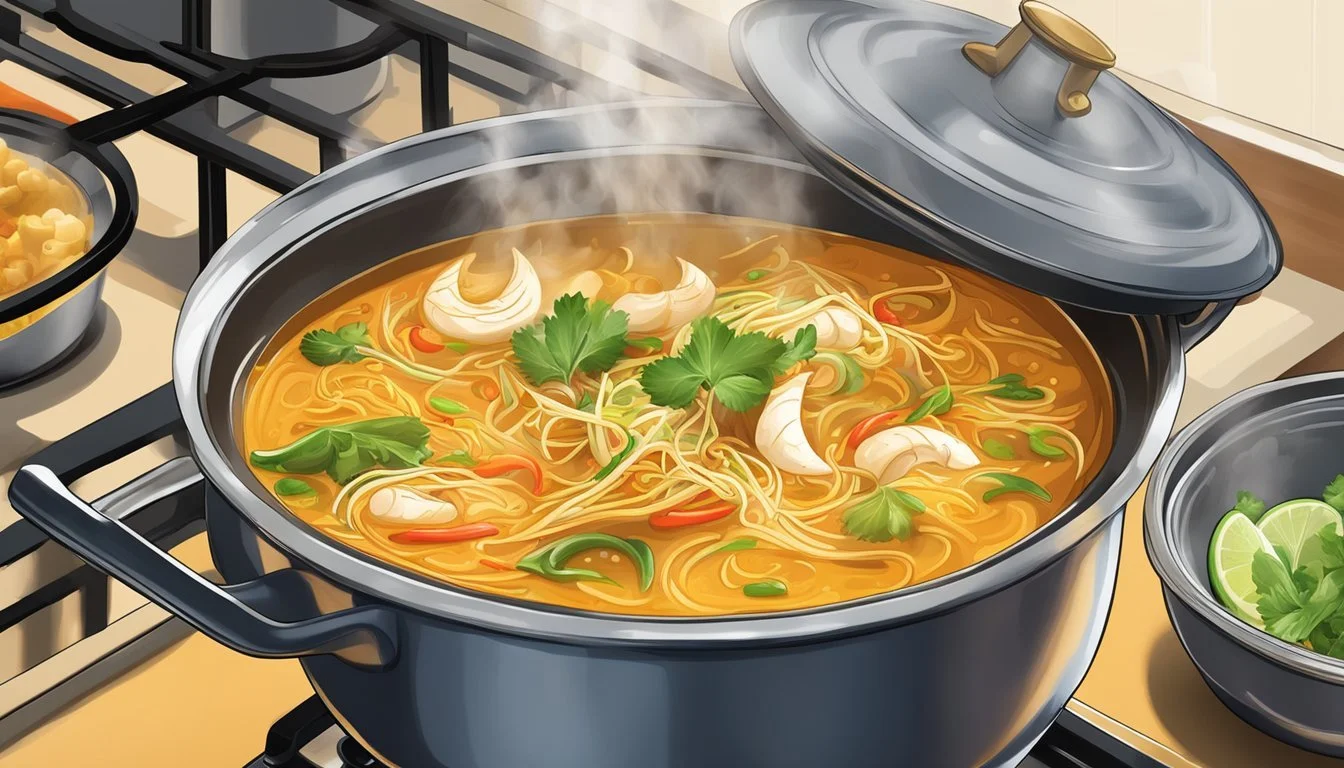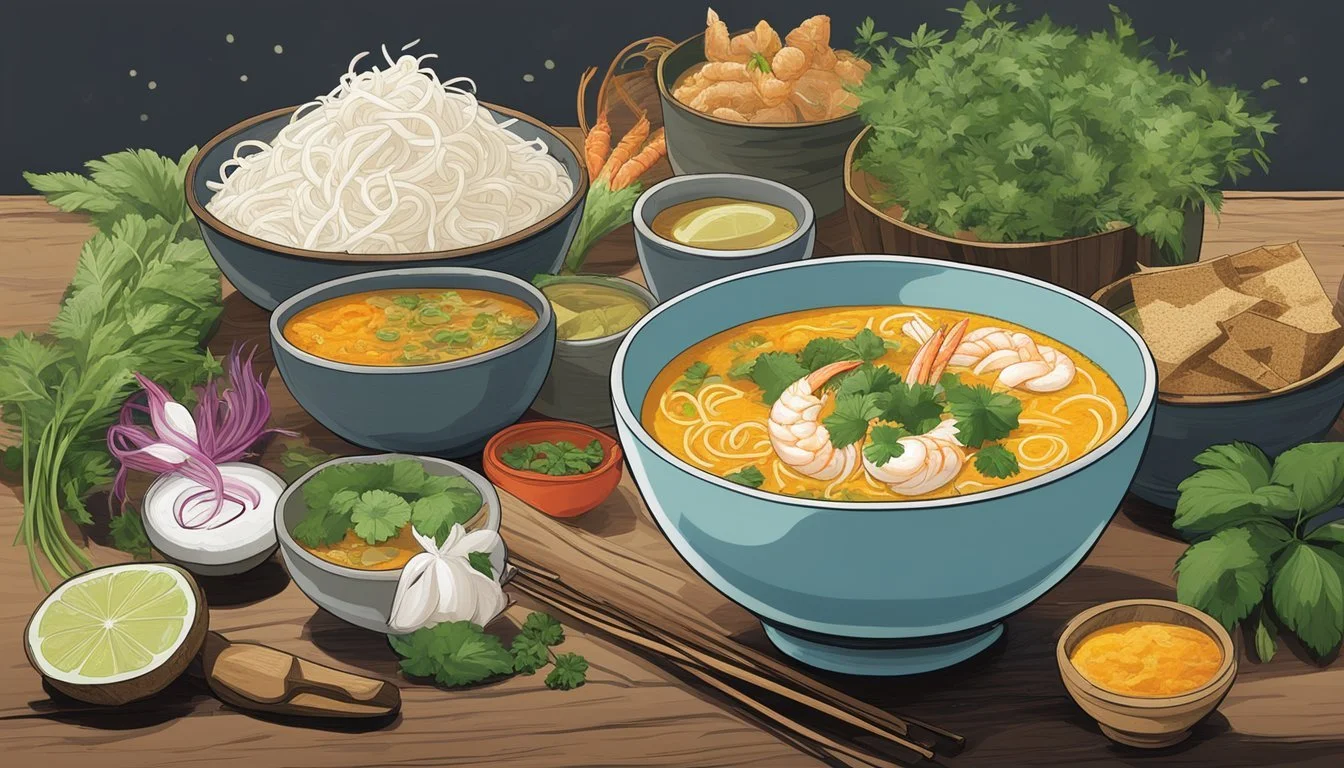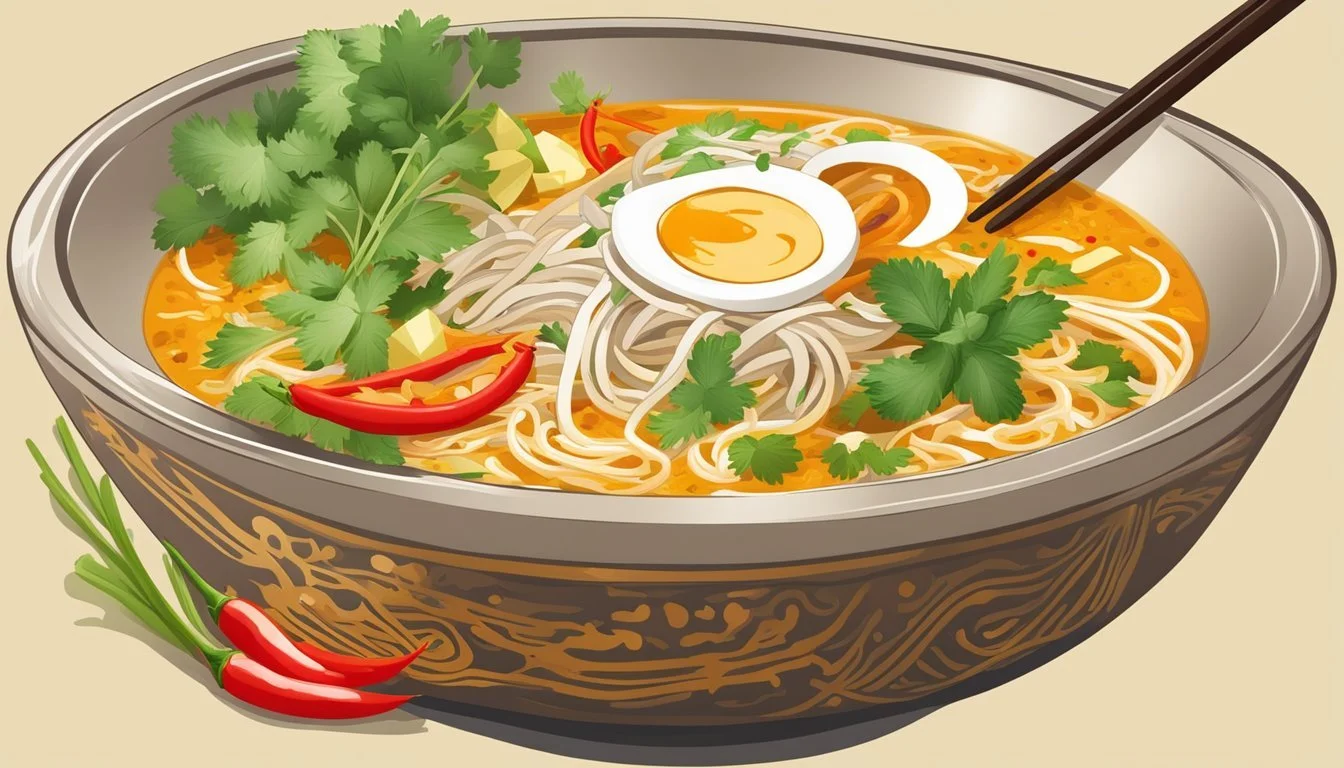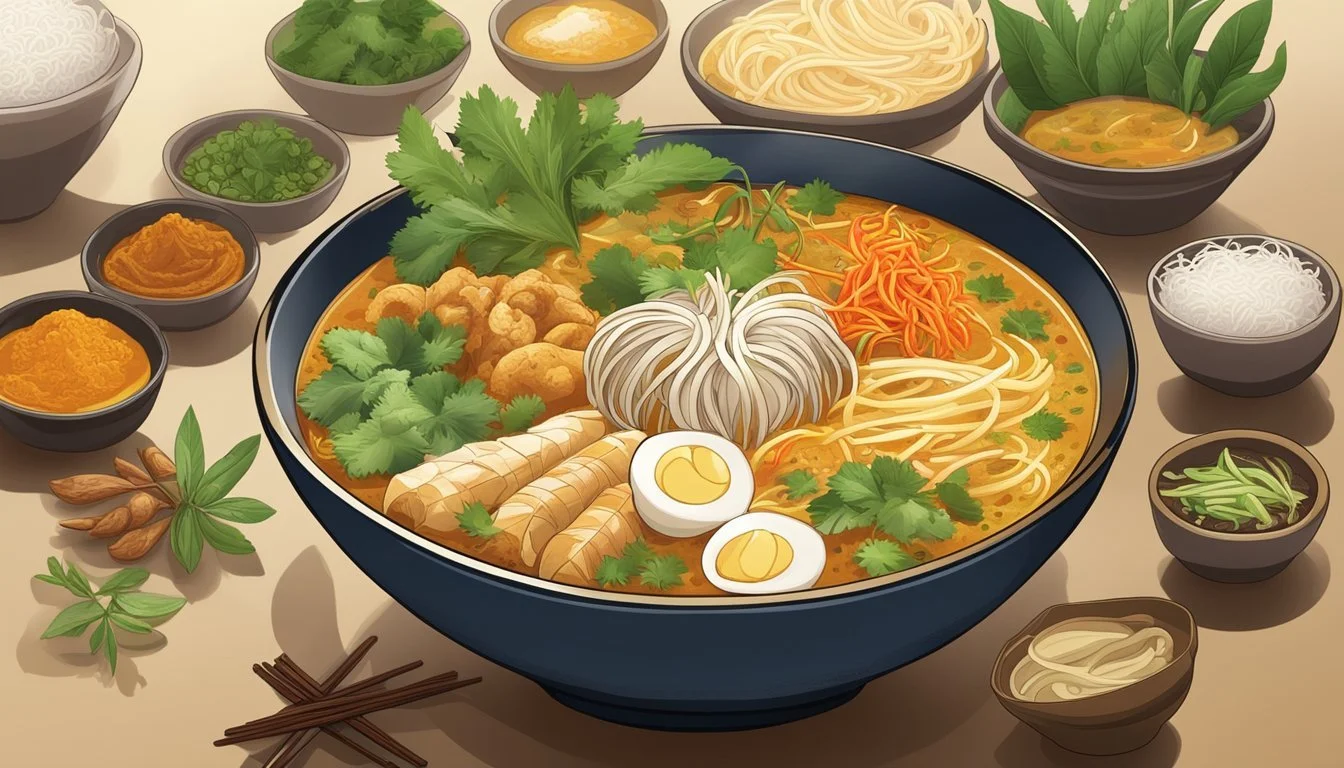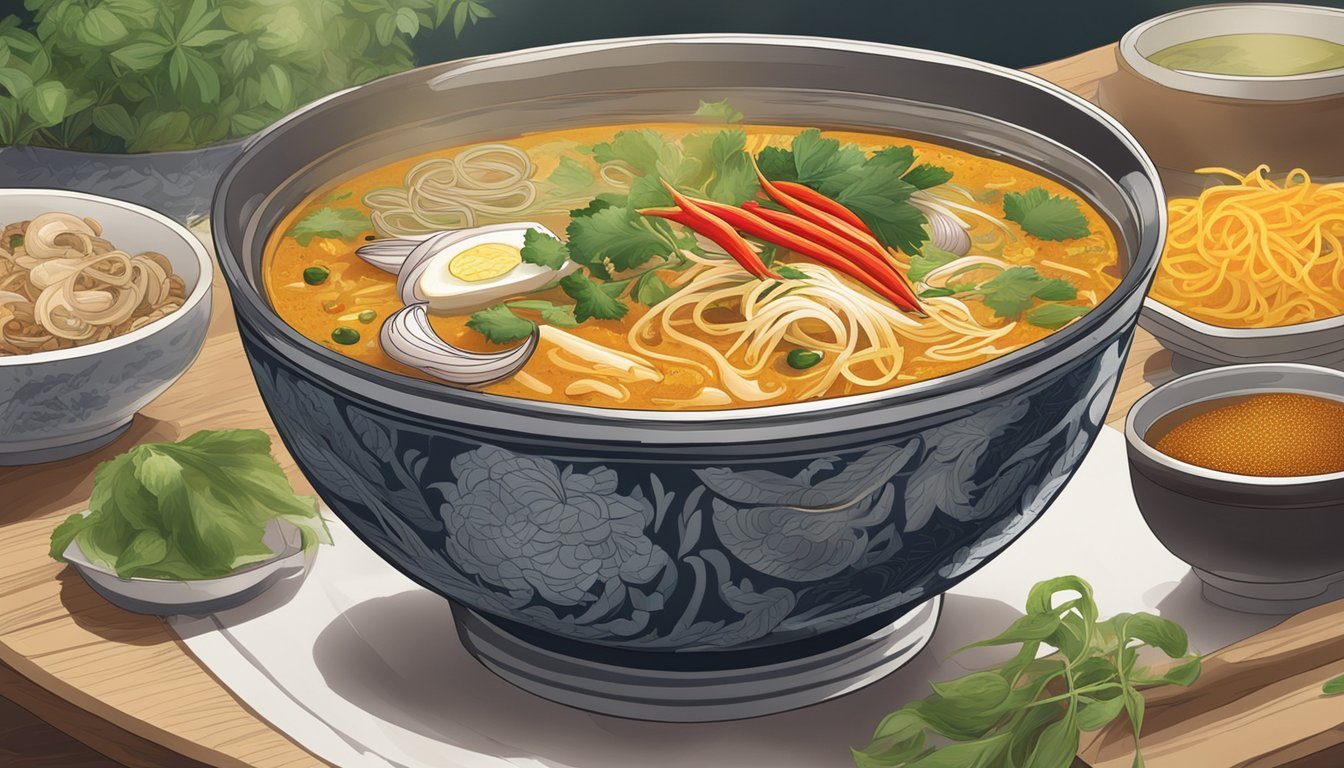Best Way to Reheat Malaysian Curry Laksa
Preserving Flavor and Aroma
Malaysian Curry Laksa is a beloved dish known for its rich and aromatic broth, blending spices, coconut milk, and a mixture of noodles and proteins. Ensuring that this complex dish retains its distinctive flavors when reheated is a challenge for many. To maintain the integrity of Laksa’s characteristically spicy and fragrant broth, certain reheating techniques must be employed so that the essential balance of its nuanced taste profile is preserved.
Reheating Curry Laksa calls for respect for its delicate ingredients and understanding of the layering of its flavors. Given that the dish encompasses both tender noodles and a variety of toppings, such as chicken, shrimp, or tofu, combined in a spicy coconut milk-based soup, the reheating method must ensure that noodles do not become overly soft and toppings stay succulent. Success lies in applying gentle heat and avoiding direct microwave reheating, which can unevenly distribute temperature and compromise texture.
A correct approach will reinvigorate the Laksa’s broth without dulling its vibrant spices or causing a separation of the coconut milk. By following best practices in recreating the dish’s freshly served warmth, one can enjoy a reheated bowl of Laksa that resonates with the same appealing harmony as when it was first prepared. This underscores the significance of the reheating process as an extension of the preparation itself, a crucial step that upholds the culinary tradition and taste expectations surrounding this treasured Malaysian classic.
Understanding Malaysian Curry Laksa
Malaysian Curry Laksa, often referred to simply as Laksa or Nyonya Laksa in Southeast Asia, stands out as a quintessential comfort dish. It's a spicy noodle soup that embodies the complexity and richness of Malaysian cuisine. This delectable dish is a harmonious blend of Chinese and Malay flavors, making it a staple in Malaysian gastronomy.
The broth is the soul of the dish; made from coconut milk and infused with aromatic spice paste. The spice paste typically contains shallots, garlic, lemongrass, galangal, and dried chilies, which contribute to its characteristic spiciness and depth. Adding to this, curry spices such as coriander and cumin are often sautéed to unlock their flavors before being combined with the broth.
Ingredients:
Coconut milk
Spice paste
Shallots
Garlic
Galangal
Dried chilies
Coriander
Cumin
As opposed to the sour and fishy Asam Laksa, Curry Laksa offers a creamier and more robust flavor. The soup is adorned with ingredients like tofu puffs, seafood, and chicken, and it's paired with rice noodles that absorb the essences of the tangy and spicy soup.
Common toppings:
Tofu puffs
Shrimp
Fish balls
Chicken
Garnished with fresh herbs and sliced cucumber, Malaysia's Curry Laksa presents a medley of textures and flavors that is both comforting and invigorating. Each bowl is a reflection of Malaysia's multicultural heritage, loved for its creamy, spicy, and umami-rich soup base.
Traditional Ingredients and Variations
Malaysian Curry Laksa is a dish celebrated for its harmonious blend of spices and ingredients. Across Malaysia, versions of Curry Laksa vary, but authentic Laksa has a distinctive set of core ingredients and spices accompanied by a range of toppings and condiments that allow for personalization while maintaining the essence of the dish.
Core Ingredients of Laksa
Central to Laksa are the noodles and broth. The noodles typically used are either rice noodles or wheat noodles — each provides a unique texture. The broth is an amalgamation of laksa paste, coconut milk, and various stocks (such as fish or chicken stock) that form the soul-warming soup of the dish.
Noodles: Rice noodles (thin or thick vermicelli)
Broth components:
Laksa paste
Coconut milk
Chicken or fish stock
Aromatic and Spice Components
The aroma and taste of Laksa largely depend on its spice paste and the aromatic herbs used. The paste is a complex blend including lemongrass, galangal, turmeric, garlic, shallots, and ginger. Spices like coriander and curry powder, along with various types of chili powder, fortify the paste, providing depth and heat to the dish.
Aromatic herbs: Lemongrass, galangal, turmeric, and ginger
Spice paste ingredients:
Shallots
Garlic
Chilies or chili powder
Turmeric
Coriander
Curry powder
Additional Toppings and Condiments
Laksa is often garnished with a variety of toppings including shrimp, fish, chicken, tofu puffs, and hard-boiled eggs. The dish is typically served with a dollop of sambal (chili paste) and a squeeze of lime for a zesty kick. Fresh herbs like cilantro and mint leaves are sprinkled on top, along with fried shallots, to add a burst of freshness and a crispy texture.
Protein additions:
Shrimp
Fish slices
Chicken strips
Tofu puffs (fried tofu)
Hard-boiled eggs
Fresh garnishes:
Bean sprouts
Lime wedges
Cilantro
Mint leaves
Fried shallots
Condiments:
Sambal (chili paste)
Preflight Preparation
Properly preparing Malaysian Curry Laksa for reheating is crucial to preserving its distinctive flavor and texture. The process ensures that the aromatic and spicy broth maintains its integrity and the noodles do not become overly soft.
Preserving Laksa for Reheating
Refrigerated: Laksa should be stored in an airtight container and can be kept refrigerated for up to two days. The coconut milk-based broth must be cooled swiftly before being sealed to prevent spoilage.
Broth and Noodles: It is recommended to store the broth and noodles separately. This prevents the noodles from absorbing too much broth and becoming soggy.
Vegetable and Toppings: Any vegetable or additional toppings should be stored in separate containers to maintain their freshness and to avoid them becoming wilted or soft.
Pre-Reheating Tips
Gently Reheat Broth: When reheating the laksa broth, it should be done slowly over a low heat to prevent the coconut milk from separating and to retain the aromatic profile of the spices.
Separate Noodles: Reheat noodles by briefly submerging them in boiling water just until they are warmed through. Keep a close eye to ensure they maintain their texture.
Recombine with Care: After both components have reached the desired temperature, they can be combined to ensure each serving of laksa is as close to the original recipe's intended flavor and texture.
Reheating Techniques
When reheating Malaysian Curry Laksa, one aims to maintain the integrity of its aromatic and spicy broth. The following methods are aimed at preserving the texture and flavors of the soup while ensuring that the coconut milk within the broth does not curdle.
Stovetop Reheating
To reheat on the stovetop, one should gently warm the laksa on a low to medium heat. It is crucial to avoid boiling the laksa as this can cause the coconut milk to separate and the soup to lose its richness. One can add a small amount of water if the broth seems too thick.
Pour the laksa into a suitable saucepan.
Heat gently, stirring occasionally.
Monitor the temperature to prevent the soup from reaching a boil.
Microwave Reheating
Microwave reheating requires careful attention to prevent overheating the coconut milk in the broth. It should be done in short bursts and at a reduced power level if available.
Transfer a portion of laksa into a microwave-safe bowl.
Cover with a microwave-safe lid or vented plastic wrap to contain moisture.
Heat in short bursts of 30 seconds to 1 minute, stirring between each to ensure even reheating.
Maintaining Aromatic and Spicy Broth
When reheating curry laksa, the goal is to preserve the aromatic and spicy qualities that define this rich Malaysian dish. The broth's complexity, steeped in fragrant spices and umami flavors, requires careful attention during the reheating process to ensure these characteristics remain vibrant.
Gentle Heating: To avoid diminishing the aromatic oils and flavor compounds, one should reheat the broth slowly and gently. A low to medium heat setting is recommended. Stirring the broth occasionally can help to evenly distribute heat without causing any one area to overheat and lose flavor.
Separation of Ingredients: Before reheating, separate the noodles and any garnishes from the broth. This ensures that only the liquid is heated and consolidates flavors. Noodles and other additions can be separately warmed or added at the end to prevent overcooking.
Avoiding Boiling: Boiling is to be strictly avoided as it can cause the spices and coconut milk to separate, altering the desired creamy texture and potentially leading to a loss of those delicate spice notes.
Cover during Heating: Covering the saucepan can also help trap the essential vapors and prevent the evaporation of aromatic compounds.
Using these steps, the reheated curry laksa should retain its signature richness, spiciness, and aromatic intensity. By taking care not to rush the reheating process and maintaining a proper temperature, one can preserve the authentic flavors that curry laksa is celebrated for.
Serving and Garnishing
When serving the Malaysian Curry Laksa, it is crucial to focus on the visual appeal and the balance of flavors that garnishes add to the dish. Proper presentation and garnishing enhance both the taste and aesthetic of this aromatic and spicy laksa lemak.
Laksa Presentation
To serve Laksa, one should start with the noodles as the base; they may be rice noodles or a mix of rice and wheat noodles, depending on one's preference. They should be carefully arranged in a bowl, ensuring they provide a sturdy foundation for the other ingredients. Once the noodles are in place, ladle the spicy coconut broth over them, making sure to fully submerge the noodles and allowing the rich aroma to flourish.
Next, one should evenly distribute the pre-prepared toppings: shredded chicken, prawns, and fish balls are commonly added for their protein, while fried tofu puffs, having absorbed the broth, add a delightful textural contrast. Bean sprouts offer a fresh crunch, and for those who prefer a richer flavor profile, half a boiled egg can be included.
Garnish and Additional Toppings
Garnishes play a pivotal role in elevating the final presentation and providing an additional flavor boost to Laksa. It is traditional to sprinkle a handful of fried shallots over the top for a slight oniony crispness. A squeeze of fresh lime juice or a wedge of lime on the side allows guests to adjust the tanginess to their liking, thus enhancing the broth's complex flavors.
For an added kick, a dollop of sambal oelek can be offered on the side, inviting those who appreciate an extra fiery taste to tailor the heat to their threshold. Fresh herbs, such as cilantro or mint, can also be scattered on top for a punch of freshness. It is essential to present these garnishes thoughtfully, keeping them accessible yet unobtrusive, so as not to overpower the dish’s main components.
Advanced Tips for Laksa Enthusiasts
For those who have mastered the basic preparation of Malaysian Curry Laksa, these advanced tips will focus on creating a more authentic flavor and adapting the recipe to various dietary needs.
Homemade Laksa Paste and Broth
Creating a homemade laksa paste is central to achieving a rich and authentic taste. One must begin with fresh ingredients such as galangal, lemongrass, and laksa leaves, which provide the signature aroma. Shrimp paste (or belacan) is a traditional ingredient that imparts depth. For depth, blend these components with dried chilies, garlic, and shallots until smooth. Experienced cooks often prepare a substantial amount and freeze portions for later use.
The broth is another element where attention to detail makes a big difference. Simmering prawn stock or chicken broth with the homemade paste for at least 30 minutes enhances the flavors. Incorporating tamarind adds the characteristic tang, while finishing with coconut cream ensures a luxuriously smooth consistency.
Ingredient Substitutions
Adaptability is key when tailoring Laksa to meet vegetarian or vegan dietary requirements. Substitute shrimp paste with miso or soybean paste to preserve umami qualities without compromising on ethics. Vegetable stock can replace prawn or chicken broth effectively.
Instead of animal-based broths, consider utilizing a robust vegetable stock. A dash of fish sauce can be replaced by vegan alternatives like seaweed or soy sauce to maintain the dish's savory aspect. For those avoiding coconut products, consider using almond or soy milk thickened with a touch of arrowroot powder or cornstarch. This approach preserves the creamy texture while allowing for dietary flexibility.
Common Pitfalls When Reheating Laksa
When reheating Curry Laksa, enthusiasts must tread carefully to preserve the integrity of its aromatic and spicy broth. Here are key missteps to avoid:
Overcooking the Ingredients: Laksa's delicate components like tofu puffs and fish can become rubbery if subjected to excessive heat. Reheaters should aim for gentle warming, ensuring ingredients maintain their desired texture.
Separation of Coconut Milk: High heat can cause Laksa's coconut milk-base to separate, leading to an oily texture rather than a creamy emulsion. To prevent this, one must reheat over low heat and stir consistently.
Uniform Heating: Microwaves can heat unevenly, giving rise to hot and cold spots within the Laksa. A stove-top approach, with occasional stirring, is recommended for even heat distribution.
Do's Don'ts Reheat over low heat to maintain the broth's consistency. Subject Laksa to high temperatures. Stir continuously if coconut milk is a component. Leave the Laksa unattended while reheating. Evenly distribute heat by stirring, especially if using a stove. Use microwaves without caution.
In summary, successful reheating of Curry Laksa demands a gentle touch — low heat, attentive stirring, and avoidance of overcooking are crucial steps for preserving the soup's character.
Frequently Asked Questions
In this section, the reader will find essential information on preserving the exquisite taste of Malaysian Curry Laksa, understanding its regional differences, and considering dietary implications when enjoying this flavorful dish.
Storing Leftover Laksa
When one has leftover Laksa, it's crucial to store it properly to maintain its aromatic quality. Laksa should be refrigerated within two hours of cooking, separated into broth and toppings to prevent the noodles from getting soggy. Stored in airtight containers, the components can last for up to 2 days in the refrigerator. To reheat, gently warm the broth on the stove and add in the noodles and proteins at the last minute to avoid overcooking.
Laksa Varieties by Region
Laksa's recipe sees slight variations across Malaysia, Singapore, and Indonesia, reflecting the rich diversity of Southeast Asian culinary tradition. For instance, the Penang Laksa from Malaysia favors a more spicy and sour taste, while the Singaporean Laksa is known for its rich, coconut milk-based broth. Regional protein choices range from chicken and seafood to tofu, catering to both meat-eaters and vegetarians alike.
Health Benefits and Dietary Considerations
Laksa, being an Asian dish rich in proteins and spices, offers a variety of health benefits. Ingredients such as ginger and lemongrass in the spice paste have anti-inflammatory properties. However, due to its richness from coconut milk and potential high sodium content, those with specific dietary requirements should enjoy Laksa in moderation. Culinary adaptations can be made for lighter versions using low-fat coconut milk and reduced-sodium broths.

